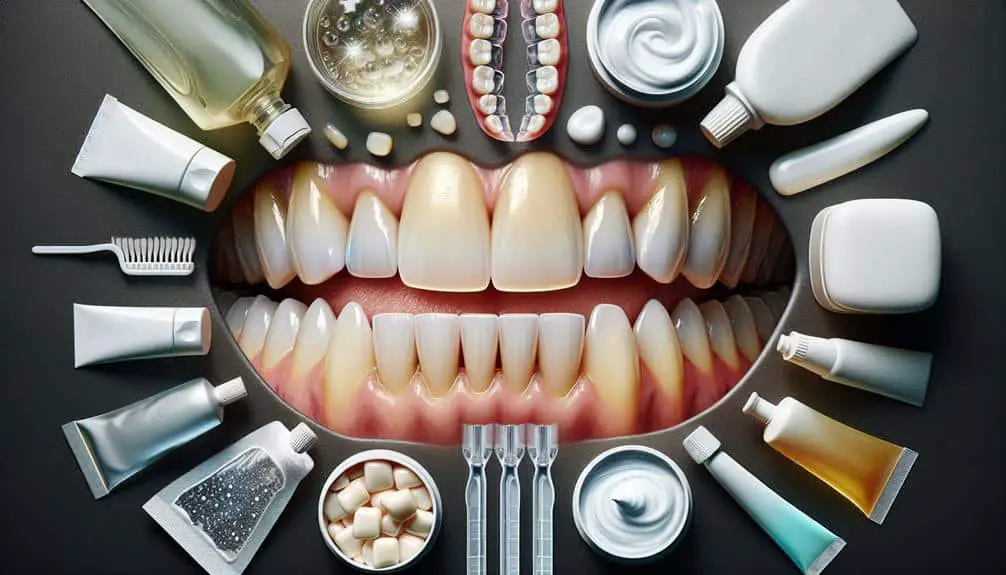Brighten your aging teeth at home by trying natural remedies like oil pulling with coconut or sesame oil to promote gum health and freshen breath. Consider using charcoal toothpaste to lift surface stains caused by pigmented foods, but always consult your dentist first. Maintaining oral hygiene with regular brushing, flossing, and dental checkups is essential. DIY treatments with baking soda and hydrogen peroxide paste or a mixture of lemon juice can aid in whitening, and watch out for foods and drinks like coffee and red wine that can stain your teeth.
Lifestyle changes such as consuming antioxidant-rich foods and limiting sugary snacks can also help. Incorporate these tips for a brighter smile and healthier teeth.
Key Points
- Oil pulling with coconut or sesame oil reduces discoloration and bacteria for whiter teeth.
- Use charcoal toothpaste to remove surface stains caused by aging and pigmented foods.
- Try baking soda and hydrogen peroxide paste for gentle surface stain removal.
- Incorporate whitening mouth rinses like lemon juice and water into your routine.
- Consume foods rich in antioxidants and limit staining beverages for a brighter smile.
Natural Remedies for Whitening Teeth
To naturally whiten your teeth at home, consider incorporating these effective and easy-to-use remedies into your oral care routine. Oil pulling is a traditional method that involves swishing oil, such as coconut or sesame oil, in your mouth for about 15-20 minutes to help remove plaque and bacteria that can lead to yellowing of teeth. This technique can also promote gum health and freshen your breath.
Another option to enhance the whiteness of your teeth is to use charcoal toothpaste. Activated charcoal has become a popular ingredient in oral care products due to its ability to attract and remove toxins and stains from the teeth's surface. Charcoal toothpaste can help in whitening your teeth by effectively lifting and removing surface stains caused by coffee, tea, or other pigmented foods.
Incorporating oil pulling and charcoal toothpaste into your daily oral care routine can be simple yet effective ways to naturally whiten your teeth at home. Remember to consult with your dentist before trying any new whitening methods to make sure they're suitable for your dental health.
Best Practices for Maintaining Oral Hygiene
Maintain ideal oral hygiene by incorporating consistent and thorough dental care practices into your daily routine. To guarantee your teeth and gums remain healthy, follow these preventive measures:
- Brushing: Brush your teeth at least twice a day using fluoride toothpaste to eliminate plaque and prevent cavities.
- Flossing: Make flossing a daily habit to clean between your teeth and along the gumline, where your toothbrush may not reach.
- Regular Dental Checkups: Schedule routine dental checkups every six months to detect any oral health issues early and receive professional cleanings.
DIY Whitening Treatments to Try
Try out these effective DIY whitening treatments to enhance the brightness of your aging teeth. Quick fixes like baking soda and hydrogen peroxide paste can help remove surface stains. Mix a small amount of baking soda with hydrogen peroxide to create a paste, then brush your teeth gently with it. Remember not to use this treatment too frequently as it may cause enamel damage if overused.
Another home remedy to explore is oil pulling with coconut oil. Swish a tablespoon of coconut oil in your mouth for about 15-20 minutes to help reduce bacteria and plaque buildup that can contribute to discoloration.
Additionally, using a mixture of lemon juice and water as a mouth rinse can aid in whitening teeth due to its acidic nature. However, exercise caution with this treatment as the acid in lemon juice can erode tooth enamel over time.
These DIY treatments offer natural alternatives to commercial whitening products and can be incorporated into your oral care routine for a brighter smile.
Foods and Drinks to Avoid
Minimize consumption of highly pigmented foods and acidic beverages to preserve the whiteness of your teeth as you age. Staining culprits like coffee, red wine, and dark berries can gradually discolor your teeth over time, making them appear yellow or dull. To maintain a brighter smile, consider making dietary adjustments to reduce your intake of these teeth-staining substances.
Here are some foods and drinks to avoid:
- Coffee: Its dark pigmentation can seep into the enamel, leading to visible stains on your teeth.
- Red Wine: The acidity and deep color of red wine make it a double threat to your teeth's whiteness.
- Dark Berries: Blueberries, blackberries, and other deeply pigmented berries contain compounds that can adhere to your teeth, causing staining.
Lifestyle Changes for a Brighter Smile
To achieve a brighter smile, implementing lifestyle changes is essential for maintaining the whiteness of your teeth as you age.
Dietary adjustments play a significant role in the color of your teeth. Consuming foods rich in antioxidants like fruits and vegetables can help combat staining and discoloration. Avoiding sugary snacks and drinks that contribute to plaque buildup is also pivotal for a radiant smile.
Additionally, incorporating daily habits such as brushing your teeth at least twice a day and flossing regularly can prevent yellowing caused by plaque and tartar accumulation. Remember to use a whitening toothpaste approved by dental professionals to gently remove surface stains.
Limiting your intake of coffee, tea, and red wine can also aid in maintaining the brightness of your teeth. By making these simple lifestyle changes, you can enhance the whiteness of your aging teeth and achieve a more youthful smile.
Frequently Asked Questions
Can Aging Teeth Be Safely Whitened at Home Without Causing Damage?
You can safely whiten aging teeth at home with professional options like whitening kits. Remember safety concerns and consider cosmetic dentistry for enamel protection. Always follow instructions carefully to achieve the best results without causing damage.
Are There Any Specific Natural Remedies That Can Target Yellowing or Staining on Aging Teeth?
For natural solutions targeting yellowing or staining on aging teeth, consider DIY options like baking soda or hydrogen peroxide. These can be effective, but safety is essential. Consult your dentist for advice on their use.
How Long Can It Take to See Results From At-Home Whitening Treatments for Aging Teeth?
Wondering how long it takes to see results from at-home whitening treatments for aging teeth? Typically, treatment duration varies, but expect noticeable effects within a few weeks. Be mindful of sensitivity and enamel health throughout the process.
Are There Any Over-The-Counter Products or DIY Treatments That Should Be Avoided for Whitening Aging Teeth?
Avoid harmful ingredients and false promises in over-the-counter products. Be cautious of unproven methods and DIY dangers for whitening aging teeth. Stick to reputable brands and consult with a dentist before trying new treatments.
Are There Any Long-Term Effects or Risks Associated With Whitening Aging Teeth at Home?
When whitening aging teeth at home, consider the long-term effects and risks. Safety is paramount to avoid potential damage. Prioritize oral health and consult a dentist for guidance on maintaining brightness without compromising the health of your teeth.
Conclusion
As you start on your journey to whiten your aging teeth at home, remember that your smile is like a beacon of light, shining brightly for all to see.
By integrating natural remedies, maintaining good oral hygiene, trying DIY treatments, avoiding certain foods and drinks, and making lifestyle changes, you can achieve a brighter, more radiant smile that symbolizes health and vitality.
Keep up with these tips and watch as your teeth sparkle like diamonds in the sun.



